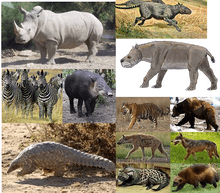Zooamata
Zooamata is a proposal for a clade of mammals uniting the Ferae (carnivores and pangolins) with the Perissodactyla (odd-toed ungulates). The name is constructed from Greek and Latin to mean "animal friends", a reference to the inclusion of cats, dogs, and horses.
| Zooamatans | |
|---|---|
 | |
| Scientific classification | |
| Kingdom: | Animalia |
| Phylum: | Chordata |
| Class: | Mammalia |
| (unranked): | Pegasoferae |
| (unranked): | Zooamata |
| Subgroups | |
Zoomata was proposed as one of the competing arrangements for the interordinal relationships of placental mammals within Laurasiatheria.[1] It received support in a phylogenetic study using retroposon insertion analysis, where it was found to be the sister taxon to Chiroptera within a novel clade named Pegasoferae.[2] The Zooamata and Cetartiodactyla (even-toed ungulates and whales) together form Scrotifera.
Subsequent molecular studies have generally failed to support the proposal.[3][4][5] In particular, two recent phylogenomic studies analysing alternative theories for mammalian interordinal relationships concluded that Zooamata and Pegasoferae are not natural groupings.[6][7] The competing proposal linking the Perissodactyla and Cetartiodactyla in a clade named Euungulata, as a sister to the Ferae, in Scrotifera received stronger support.
Phylogeny
The following cladogram shows the phylogenetic relationships of laurasiatherian mammals following Nishihara et al. (2006).[2]
| Laurasiatheria |
| ||||||||||||||||||||||||||||||
- P. J. Waddell, N. Okada, and M. Hasegawa. 1999. Towards resolving the interordinal relationships of placental mammals. Systematic Biology 48(1):1-5.
- Nishihara, H.; Hasegawa, M.; Okada, N. (2006). "Pegasoferae, an unexpected mammalian clade revealed by tracking ancient retroposon insertions". Proceedings of the National Academy of Sciences. 103 (26): 9929–9934. doi:10.1073/pnas.0603797103. PMC 1479866. PMID 16785431.
- Matthee, Conrad A.; Eick, Geeta; Willows-Munro, Sandi; Montgelard, Claudine; Pardini, Amanda T.; Robinson, Terence J. (2007). "Indel evolution of mammalian introns and the utility of non-coding nuclear markers in eutherian phylogenetics". Molecular Phylogenetics and Evolution. 42 (3): 827–837. doi:10.1016/j.ympev.2006.10.002. PMID 17101283.
- Springer, M.S.; Burk-Herrick, A.; Meredith, R.; Eizirik, E.; Teeling, E.; O'Brien, S.J.; Murphy, W.J. (2007). "The adequacy of morphology for reconstructing the early history of placental mammals". Systematic Biology. 56 (4): 673–684. doi:10.1080/10635150701491149. PMID 17661234.
- Kitazoe, Yasuhiro; Kishino, Hirohisa; Waddell, Peter J.; Nakajima, Noriaki; Okabayashi, Takahisa; Watabe, Teruaki; Okuhara, Yoshiyasu (2007). Hahn, Matthew (ed.). "Robust Time Estimation Reconciles Views of the Antiquity of Placental Mammals". PLoS ONE. 2 (4): e384. doi:10.1371/journal.pone.0000384. PMC 1849890. PMID 17440620.
- Zhou, Xuming; Xu, Shixia; Xu, Junxiao; Chen, Bingyao; Zhou, Kaiya; Yang, Guang (2011). "Phylogenomic Analysis Resolves the Interordinal Relationships and Rapid Diversification of the Laurasiatherian Mammals". Systematic Biology. 61 (1): 150–164. doi:10.1093/sysbio/syr089. PMC 3243735. PMID 21900649.
- Tsagkogeorga, G; Parker, J; Stupka, E; Cotton, JA; Rossiter, SJ (2013). "Phylogenomic analyses elucidate the evolutionary relationships of bats (Chiroptera)". Current Biology. 23 (22): 2262–2267. doi:10.1016/j.cub.2013.09.014. PMID 24184098.